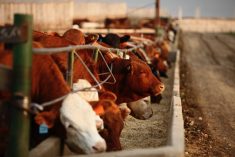Reuters — Crop watchers have raised concerns that the massive harvest of soybeans in the United States may not contain enough protein for optimal soymeal production, forcing processors to scramble to find supplies suitable for crushing.
A protein shortfall, stemming from a rainy spring and dry conditions as crops neared maturity, could add to the tightness in an already thin supply chain that has pushed both soybean and soymeal prices sharply higher this fall.
“That is what I call kind of the perfect storm for low protein,” said Seth Naeve, University of Minnesota extension agronomist specializing in soybean production. “That is to be expected in a year where we have too much water early and then tend to be too dry later.”
Read Also

U.S. grains: CBOT soybeans, corn, wheat fall in USDA data aftermath
Chicago grains took a dive on Friday, following a closely watched U.S. government crop report and the release of export data that could provide clues into Chinese buying.
Reports from processing plants have been mixed as soybeans have started to arrive, making it difficult to asses the extent of the problem.
“I am seeing lower protein and lower oil yield,” a dealer at a processing plant in the western Midwest said. “The plant was not stressed. Typically when it gets stressed it fights for the extra (protein).”
But other dealers have seen no issues with bean quality so far.
“It is within the realm of average,” a dealer at a processor in Council Bluffs, Iowa. “Nothing to write home about.”
Dealers were noting high variability in the soybeans they were taking in, with reports of protein concerns generally greater in western areas of the U.S. Midwest.
A variable soybean crop could boost costs for processors such as Bunge Ltd, Archer Daniels Midland Co, Cargill Inc and Louis Dreyfus Corp. The companies would have to shuttle crushing supplies between facilities to ensure that plants get the soybeans they need. A clogged transportation system could slow that process and further push up costs.
Country movement of soybeans has been lighter than usual. Low prices in September and early October caused many farmers to move newly cut crops straight into storage. The slow deliveries could delay the unveiling of protein problems.
But the crops received so far have not raised major alarms.
“It is generally speaking good, both in protein and in oil content,” Bunge Chief Executive Soren Schroder said in an interview.
Protein shortfalls could lead to some soymeal being moved out below the standard 47.5 per cent level or delay shipments as exporters scramble to meet huge demand from overseas buyers.
“I am pretty sure we will hear some static from our international buyers,” said Charles Hurburgh, a professor of agricultural and biosystems engineering at Iowa State University.
Importers have already committed to buy 6.4 million tonnes of U.S. soymeal by late October, the most ever, for the 2014/15 crop year. The U.S. Agriculture Department has estimated soymeal exports of 10.89 million tonnes this year.
The robust demand and resulting supply crunch have fueled a rally in the futures market, with prices for Chicago Board of Trade soymeal surging 25 per cent during October.












